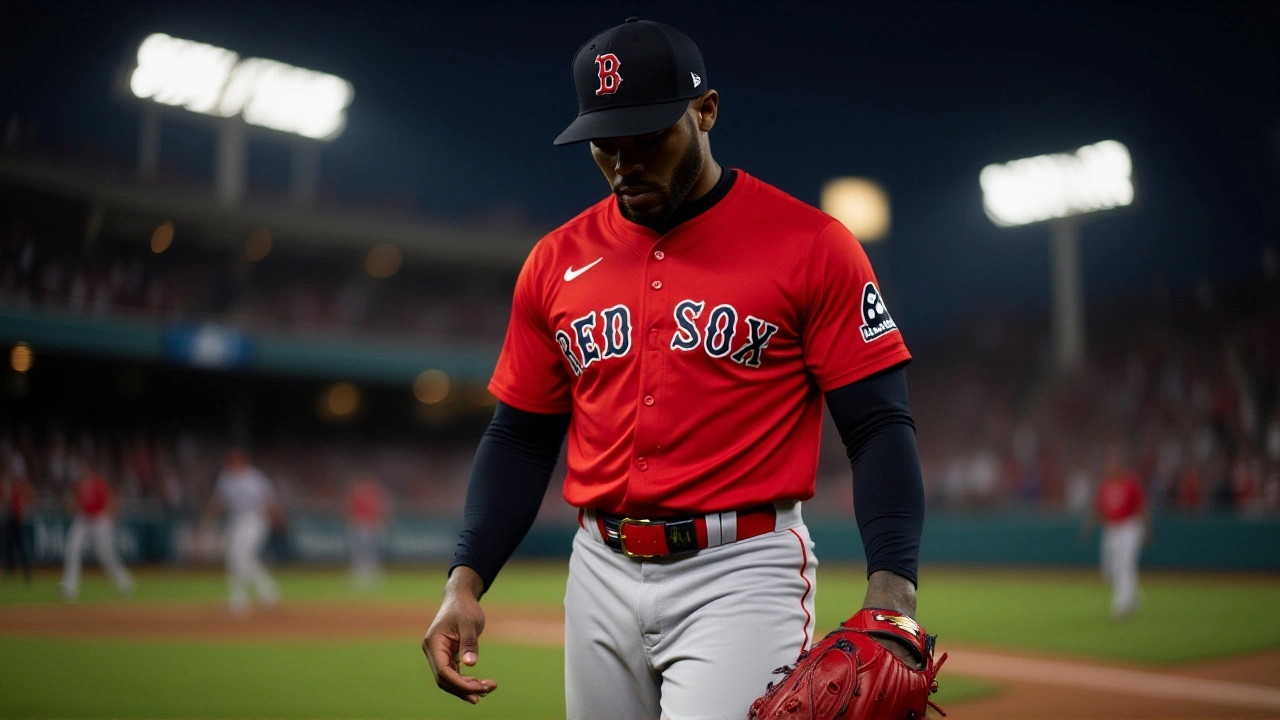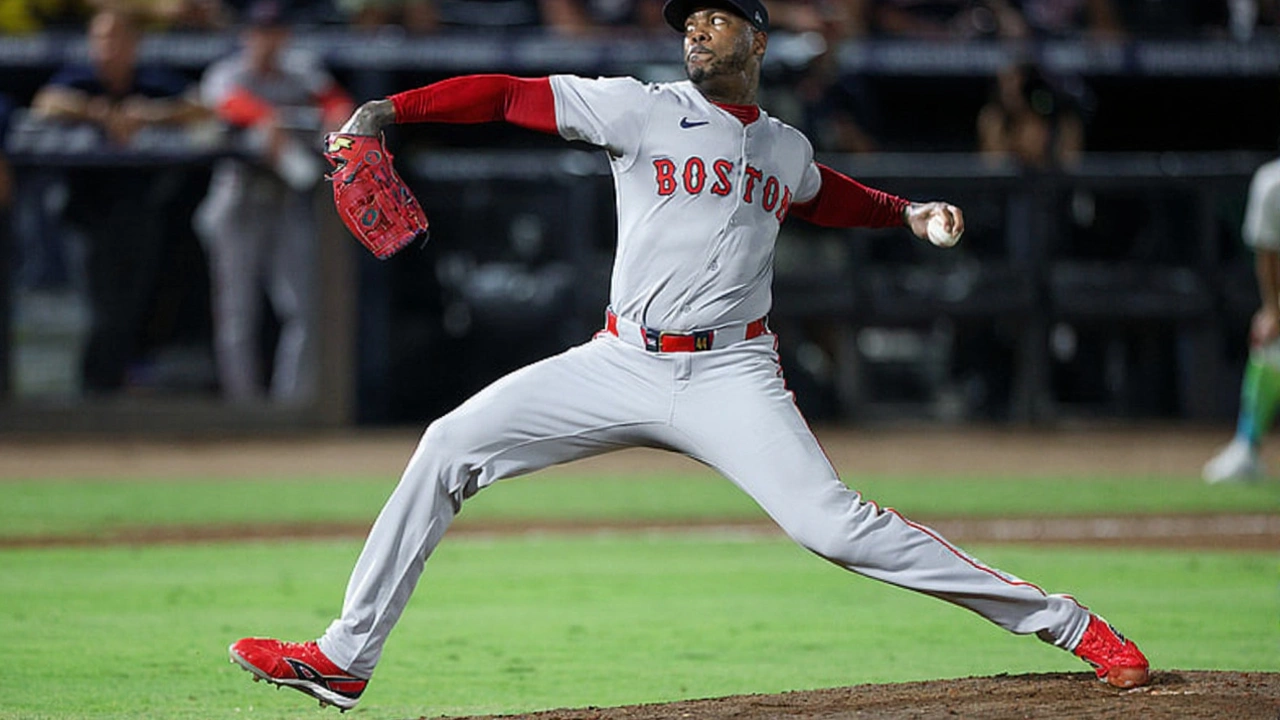When Aroldis Chapman, the left‑handed closer for the Boston Red Sox, signed a one‑year extension on August 31, 2025, the baseball world took notice. The deal, which also features a mutual option for 2027, was announced by the club in a brief statement posted on its official website. Alex Cora, the Red Sox manager, praised Chapman’s "unprecedented consistency" during a press conference held at Fenway Park that same afternoon.
Background and Contract Details
The extension was first reported by BeisbolFR journalist Francys Romero on August 30, with MassLive’s Chris Cotillo adding further specifics the next day. Under the new terms, Chapman receives a $1 million signing bonus and a $12 million salary for the 2026 season. The mutual option for 2027 is worth $13 million, with a $300,000 buyout if the club declines. If Chapman throws at least 40 innings in 2026 and passes a post‑season physical, the option becomes guaranteed, pushing the total possible value to $26 million over two years. In plain language, the contract guarantees $13.3 million regardless, but the "performance trigger" could double that payout.
Chapman's 2025 Performance – A Statistical Masterclass
Chapman’s 2025 numbers read like a textbook case of a reliever at the top of his game. Through 58 appearances, he logged 27 saves and topped the league among pitchers with at least 50 innings in three key categories: a 1.02 ERA (six earned runs in 53.0 innings), a microscopic 0.66 WHIP, and a .117 opponent batting average (21 hits in 179 at‑bats). The most eye‑catching streak began on July 26, when he recorded 15 consecutive hitless outings – a franchise record – striking out 16 batters while issuing only four walks over 12.2 scoreless innings.
Even more impressive, over his last 35 games dating back to May 28, Chapman surrendered a single earned run in 32.0 innings, equating to a 0.28 ERA, 0.41 WHIP, and a minuscule .069 opponent average (seven hits in 102 at‑bats). Those figures helped him earn his eighth All‑Star selection, tying Goose Gossage for the third‑most All‑Star nods by a reliever. As baseball analyst Mike Lopresti noted, "Chapman’s strikeout‑per‑nine‑innings rate of 14.63 is historic for anyone with a 100‑inning minimum."
Red Sox’s Strategic Move
The extension arrives on the heels of a tumultuous 2024 campaign that saw the Sox trade star third‑baseman Rafael Devers in June 2025. That move, initially viewed as a cost‑cutting measure, sparked a cultural shift within the organization. Manager Alex Cora and front‑office leader Chaim Bloom have repeatedly emphasized a "next‑up" mentality, allowing younger arms to flourish while leaning on veteran reliability. Chapman’s resurgence fits perfectly into that blueprint – a proven elite closer who can anchor the bullpen while the club develops its home‑grown setup men.
Financially, the deal represents a sizable jump from Chapman’s previous one‑year, $10.75 million guarantee signed in November 2024. Yet the Red Sox’s payroll analysts, citing The Boston Globe’s Alex Speier, argue the increment is justified by the differential in Wins Above Replacement (WAR). Chapman’s 2025 WAR of 2.8 dwarfs the league average for relievers, translating to roughly $7 million in value – a respectable return on a $12 million salary.

Reactions from Players, Agents, and Analysts
"I’m thrilled to keep doing what I love in a city that respects the grind," Chapman said, his trademark grin evident. His agent, Wasserman, released a statement noting that the clause tied to innings and health reflects Chapman’s confidence in his durability.
Teammate Brandon Phillips (second baseman) chimed in later, "Aro’s a locker‑room guy. When he shuts the door, you know the game’s in the bag." Meanwhile, veteran broadcaster Bob Lobel warned, "The mutual option is a gamble. If Chapman slips or the injuries pile up, Boston could be stuck with a hefty buyout. But looking at his 2025 trend, the risk feels minimal."
Future Outlook – What Comes Next?
Looking ahead to the 2026 season, the Sox will likely lean on Chapman to bridge the gap while they court a young fireballer for the eventual closer role. If Chapman meets the 40‑inning trigger, the club will face a $13 million commitment for 2027, a figure that could shape future free‑agent decisions. Some insiders speculate that Boston may explore a trade package for Chapman should his health decline, but the consensus among scouts is that the left‑hander still has several high‑velocity years left.
On a broader scale, the extension signals Boston’s willingness to invest in elite bullpen talent despite a recent focus on cost control. As the market for top relievers continues to inflate – think Josh Hader’s $30 million contract – the Sox’s deal could be a benchmark for clubs balancing payroll flexibility with the need for a shutdown closer.
Key Facts
- Extension signed August 31, 2025, covering the 2026 season with a 2027 mutual option.
- Salary: $12 million in 2026; $13 million guaranteed if 40 innings are pitched.
- Signing bonus: $1 million; buyout: $300,000.
- 2025 stats: 27 saves, 1.02 ERA, 0.66 WHIP, .117 opponent BA.
- Franchise record: 15 straight hitless appearances (July 26‑August 15).

Frequently Asked Questions
How does the extension affect the Red Sox’s bullpen strategy?
By locking up Chapman through 2026 (and potentially 2027), Boston can build its late‑inning game plan around a proven closer. This gives the club time to develop younger relievers in lower‑leverage situations without compromising the ability to protect a lead in the final innings.
What are the financial risks if Chapman fails to meet the 40‑inning threshold?
Should Chapman pitch fewer than 40 innings or miss the post‑season physical, the Sox would forfeit the $13 million guarantee and instead pay a $300,000 buyout. While that’s a sizeable sum, it’s a fraction of the $26 million potential payout and reflects the club’s bet on his durability.
Why did the Red Sox pursue a mutual‑option rather than a player‑option?
A mutual‑option balances risk between player and club. It rewards Chapman for staying healthy while giving Boston the flexibility to walk away if his performance drops, a prudent move after the volatility of his 2023‑2024 seasons.
What does this deal mean for other teams looking for elite closers?
The contract sets a market reference point for premium left‑handed relievers. Teams will likely use the $12 million base as a baseline, adjusting up or down based on age, recent workload, and health history.
How did Chapman’s 2025 performance compare to other elite relievers?
Chapman led the league in ERA, WHIP, and opponent batting average among pitchers with at least 50 innings, eclipsing peers like Josh Hader and Liam Hendriks. His 15 straight hitless outings also set a franchise record, underscoring his dominance.
